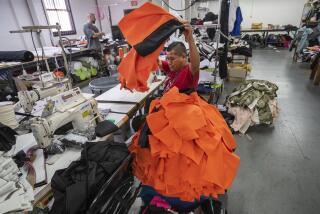Factory Orders Up 4.1%, Biggest Jump in 2 Years : Surge in Demand for Military Equipment Paces Increase; Analysts Lay Gain to Temporary Factors
WASHINGTON — Orders to U.S. factories, spurred by a surge in demand for military equipment and a rush to beat tax overhaul, climbed 4.1% in November, the biggest increase in two years, the Commerce Department reported Friday.
The department said total new orders rose by $7.9 billion in November to stand at $200.4 billion after falling 3.5% in October.
While such a big increase would normally be seen as positive for the country’s beleaguered manufacturing sector, many analysts said the November gain was influenced by temporary factors that offered little evidence that manufacturers will enjoy increased demand in the new year.
November’s increase was led by the largest one-month rise in military orders in 12 years, a 107.9% surge that reflected heavy demand for defense aircraft. The defense increase, which followed a 43.4% decline in October, left military orders at $10.4 billion.
Without the big defense increase, orders would have gone up a much smaller 1.13% in November, and some analysts said even this gain was overstating future economic strength.
Last-Minute Rush
They attributed much of the advance in the civilian categories to a last-minute rush by businesses to buy and take delivery on capital equipment to qualify for higher tax benefits that expired on Jan. 1.
“Even though the overall number looks impressive, when you look more closely it completely evaporates,” said Michael Evans, head of a Washington consulting firm. “It isn’t telling us anything about future strength.”
Evans said he believed that the economy limped along at a 1.5% annual rate in the just completed October-December quarter, and he said growth in the January-March period would slump to a negative 1% as businesses and consumers cut back on spending with the advent of the new tax law.
Douglas Cliggott, senior economist at the New York investment house of Merrill Lynch, said it was evident that much of the increase in the November orders could be traced to the impending tax law changes.
“A lot of businesses were trying to get their equipment in place before year-end,” he said.
Non-defense capital spending climbed 6.4% as businesses placed rush orders to qualify for more lucrative tax treatment under the old law. Business capital spending to expand and modernize had fallen 4.6% in October.
In another report Friday, the Commerce Department said construction spending fell for a second consecutive time in November, a 0.7% decline that left spending at a seasonally adjusted annual rate of $377 billion. Analysts said construction spending will weaken further in coming months as a result of widespread overbuilding of apartments and office buildings and the removal of many tax benefits under the new tax law.
Durable Goods Report
The report on factory orders said two-thirds of the $7.9-billion increase in orders occurred in the durable goods sector, which rose by 5.5% in November. In an advance report 10 days ago, the government had put the increase in durable goods, items expected to last three or more years, at a slightly higher 5.9%.
Within the major industry categories, orders for transportation equipment rose 15.9%, powered by an 85.3% increase in orders in the aircraft and missiles category. Without the big increase in defense orders, demand in the transportation category would have fallen 6.3%.
Machinery orders were up 12.2%, led by a 16.2% rise in orders for office equipment.
Orders for non-durable goods rose 2.5% to $91.15 billion after having fallen 1.9% in October.
Shipments of manufactured goods rose 1% to $198.2 billion, with two-thirds of the $2-billion rise attributed to a pickup in shipments of defense goods.
More to Read
Inside the business of entertainment
The Wide Shot brings you news, analysis and insights on everything from streaming wars to production — and what it all means for the future.
You may occasionally receive promotional content from the Los Angeles Times.










